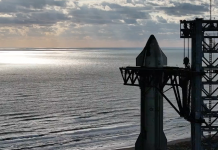SpaceX is already preparing for the next Starship launch – the SN11 prototype is installed on the launch pad
Less than a week has passed since the landing (and subsequent explosion) of the previous SN10 prototype of the Starship launch vehicle, and SpaceX is already preparing for another test flight. A prototype SN11 was set up yesterday at a launch pad near Boca Chica’s village in South Texas in anticipation of the upcoming launch.





